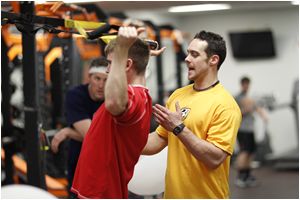Training Methodology
 The human body is a masterpiece that is constructed of millions of cells, each of which has a specific purpose. So why not train each cell with a purpose? Many training programs today approach the athlete with two goals in mind: To create an athlete who has more strength than their opponent, or train to prevent injury. Both of these ideas are important, but what good is one without the other? And what about the many other training goals involved with creating the perfect athlete? That’s where 3D Performance Training bridges the gap; the science of training meets the application of real world competition.
The human body is a masterpiece that is constructed of millions of cells, each of which has a specific purpose. So why not train each cell with a purpose? Many training programs today approach the athlete with two goals in mind: To create an athlete who has more strength than their opponent, or train to prevent injury. Both of these ideas are important, but what good is one without the other? And what about the many other training goals involved with creating the perfect athlete? That’s where 3D Performance Training bridges the gap; the science of training meets the application of real world competition.
Maybe it is easier to look at it like this; under normal activity each person has baseline of athletic ability. In order to maximize performance it is imperative that all systems be trained to handle specific workloads. At 3D we train thoroughly at both ends of the spectrum; Pushing each person to their physical and mental limits while training with a pre-habilitation approach. Without carefully considering all the variables involved in each athlete’s needs, there are holes left in the training regimen which will ultimately lead to a lack in performance.
By teaching each athlete the purpose of each movement they begin to understand how important the training session will be. Through heightened concentration comes more efficient and productive training time. What separates our athletes from others is our exquisite attention to detail. It is the perfect execution of every movement that gives purpose to each training bout. By always preparing with a purpose, we can encourge perfect functional and sport specific skills away from the field. When skills are mastered in a controlled environment, performance has no option but to improve.
The human body is efficient or lazy depending on how you look at it. It will only make transform if it receives stimuli requiring a change in makeup. Each training bout must attempt to find weaknesses and trigger adaptations for better performance. By constantly applying new loads, new speeds, and new elements of sport specificity each athlete will invariably make positive strides towards being better prepared than their opponent.
Training Programs
Initial Approach to Each Athlete: To begin with each sport and position must be identified to ensure that every athlete trains (Prepares) with a purpose. Everything that is done at 3D Performance is designed to EDUCATE and push the body to its limits while protecting against injury. Due to the nature of sports, many of which require a number of unilateral movements, the body creates structural imbalances which require specific exercises to correct. While preparing to perform with maximum efficiency we can then unlock each athletes hidden potential. It’s no secret that a healthy athlete is a more valuable athlete.
Once the initial needs are established then the real training begins. It’s time to lay a foundation that will ultimately lead to success on the field, on the court, in the water, or even in the air! During training or competition sometimes it is not the body that fails, IT IS THE MIND! We’ll help you realize what your body is capable of. No matter the sport, 3D Performance can help to improve performance: Baseball, Basketball, Football, Soccer, Tennis, Volleyball, Golf, Swimming, Diving, Gymnastics, Hockey, Lacrosse, Sprinters, Endurance Athletes more.
Speed Development
Just think what it would be like to be able to flip an internal switch and explode past your opponent at your command. Games can change in an instant when players are able to reach a spot on the field or court before their opponent.
Sometimes scholarships are earned and contracts are agreed upon because of the importance of speed in sports. Many make the assumption that strength equals speed; that is only a small piece of the puzzle. Without proper mechanics, systematic training, and enhanced neuromuscular efficiency, maximum running velocity will virtually never be achieved. Maximum sprinting velocity in its simplest form is accomplished by sustaining optimum stride length and foot speed. This seems easy, but it is imperative that each is executed perfectly while not being detrimental to the other. In other words, increasing stride length alone may not make an athlete faster if it is detrimental to foot speed or stride turnover.
When the brain learns new movement patterns it can cause an athlete to feel awkward and uncoordinated. As these new skills begin to develop, the efficiency and speed of each movement increases. Increased speed in conjunction with strength creates power; and as power increases so does performance. The athlete is then able to use less effort to produce results.
